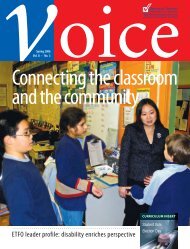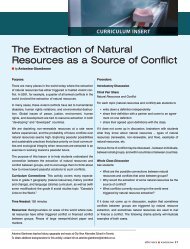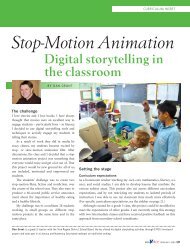Summer 2006 - The member magazine of the Elementary Teachers
Summer 2006 - The member magazine of the Elementary Teachers
Summer 2006 - The member magazine of the Elementary Teachers
Create successful ePaper yourself
Turn your PDF publications into a flip-book with our unique Google optimized e-Paper software.
<strong>The</strong>re are not a lot <strong>of</strong> children complaining that<strong>the</strong>y don’t know what to do any more. Boys andgirls play toge<strong>the</strong>r.bullying programs, and a variety <strong>of</strong> health and safety lessons. But, notes Allin,“everything went pretty smoothly. Staff was receptive to time slots allotted to<strong>the</strong>ir classes for activity periods and worked <strong>the</strong>ir schedules around it.”Twice a week, on days when <strong>the</strong>re are no regular phys. ed. classes, all threeintermediate classes go outside toge<strong>the</strong>r for 40 minutes just before <strong>the</strong> firstnutrition break. (Queen Elizabeth II operates on balanced day).<strong>Teachers</strong> join in, modelling sportsmanship while helping build schoolspirit. <strong>The</strong>y try to vary activities, keeping at least three choices such as basketball,touch football and dodge ball available at once. Some days, <strong>the</strong>y walk <strong>the</strong>perimeter <strong>of</strong> <strong>the</strong> yard, or follow a route through <strong>the</strong> neighbourhood.“<strong>The</strong> fun factor is really important,” comments Grade 8 teacher MattCoatsworth. “One <strong>of</strong> <strong>the</strong> favourite games is dodge ball. Students keep scoreby <strong>the</strong> number <strong>of</strong> times <strong>the</strong>y hit <strong>the</strong> teacher with <strong>the</strong> ball. It adds a specialchallenge to <strong>the</strong> game.”“Students are more productive in class. We have 40 minutes to do whatwe would o<strong>the</strong>rwise accomplish in 60 minutes. We don’t look at it as missingtime from math, science or French so much as having more efficienttime,” Coatsworth points out.Students <strong>the</strong>mselves have noticed a change. “I used to play a lot <strong>of</strong> videos,”said Aaron L’Ecuyer, a Grade 8 student leader. “Since I joined teams,I’d ra<strong>the</strong>r be outside when it’s warm. In <strong>the</strong> winter I go to <strong>the</strong> Y. If I seesomeone standing alone, I try to ask <strong>the</strong>m to join in or encourage <strong>the</strong>m todo something like shoot hoops.”<strong>The</strong> kids do lots <strong>of</strong> things that don’t necessarily involve skill or have aconnection to a sport. Supervising teachers must constantly keep moving toavoid bouncing, rolling and flying balls <strong>of</strong> all sizes, turning ropes, and runningor jumping children playing games like hopscotch, tag and grounder.Principal Deanna Blain says that not all <strong>the</strong> activity has to be organizedby adults. “Learning how to make <strong>the</strong>ir own games is important. We’repainting games like hopscotch and four square on <strong>the</strong> asphalt. We’re givingbooklets with game suggestions to <strong>the</strong> staff so <strong>the</strong>y can introduce <strong>the</strong> gamesto <strong>the</strong> children.”Grade 6 teacher, Beth Haddock has noticed that “<strong>The</strong>re are not a lot<strong>of</strong> children complaining that <strong>the</strong>y don’t know what to do any more. Boysand girls play toge<strong>the</strong>r.” When bad wea<strong>the</strong>r prevented Haddock’s class fromgoing outside for <strong>the</strong>ir activity break, she introduced a Tae Bo video.No more couch potatoesFor this activity students find <strong>the</strong>ir own spacebetween desks in <strong>the</strong> classroom. <strong>The</strong> only ruleseems to be not to knock over any plants as<strong>the</strong>y work up a sweat following <strong>the</strong>ir videoleader. “Students are more attentive after activity.<strong>The</strong>y’re ready to settle and do some work at <strong>the</strong>irbooks,” observes Haddock.“I think <strong>the</strong> activity makes us want to go outsideand do more stuff like walk. After school I’dra<strong>the</strong>r shoot hoops with friends than stay inside,”notes Ma<strong>the</strong>w Willder, who is in Haddock’sclass.Primary division classes each use an emptyclassroom on indoor activity days to work outwith two,10-minute Fit Kids video clips. Followinginstructions on <strong>the</strong> exercise video tapes notonly provides physical activity, but also helpsdevelop listening skills needed for EQAO testing.“We don’t look at <strong>the</strong> exercise requirement asan inconvenience, but as a benefit to <strong>the</strong> wholeday,” remarks Grade 3 teacher, Sharron Myers.Avery Case, one <strong>of</strong> her students, says he likesgetting energized! “Sitting is hard work. Kidsneed to wiggle. I don’t like being called a couchpotato.” Fellow student Alyssa Withington adds:“When I play school, I’m <strong>the</strong> gym teacher and wedo exercises that build muscles and get ready todo sports. I like to skip, ride my bike, climb on<strong>the</strong> monkey bars and play grounder.”Kindergarten students get 10 minutes <strong>of</strong> exercisedaily wherever it fits into <strong>the</strong>ir flexible schedule.Here, <strong>the</strong> biggest problem is controlling<strong>the</strong> excitement factor. According to JK teacher,Kristin Vandersluis, “It’s easier to handle when<strong>the</strong>re’s an EA in <strong>the</strong> room.”Dave Allin observes that <strong>the</strong>re are “two kids inparticular with remarkable changes in body sizefrom last year to this. Maybe it’s just that <strong>the</strong>y’regrowing, but <strong>the</strong>re is positive change. <strong>The</strong> kidsseem more in tune with <strong>the</strong>ir bodies and understandthat change is possible.”“It would be interesting to look at data on<strong>of</strong>fice visits,” comments Vice Principal, ByronHodgson. “I suspect <strong>the</strong>re are fewer issues on <strong>the</strong>yard, partly because <strong>of</strong> intramurals.”In <strong>the</strong> end, administrators won’t need statisticsto judge <strong>the</strong> success <strong>of</strong> <strong>the</strong> program. All <strong>the</strong>y’llhave to do is listen to students at play in <strong>the</strong> yard:“Five potato, six potato, COUCH POTATO NOMORE!”20 etfo voice SUMMER <strong>2006</strong>









